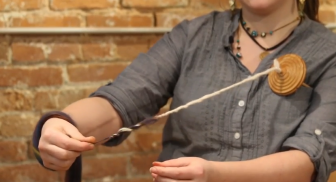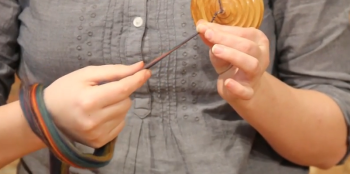The Park and Draft Drop Spinning
How to spin with a drop spindle basics
- Glossary
- Getting Started
- Common problems when drafting
- Common problem when adding twist
Spinning of any kind is simply the addition of twist to fiber to create strength, you can see this with any non-braided rope or steel cables for bridges- same idea many fibers or strands locked together are stronger and hold together longer.
I’m demonstrating on a beautiful True Creations top whorl spindle with a hook and the fiber I selected is Ashland Bay Mulit-Colored Merino Wool Top Spinning fiber “Borealis”
Note on spindles: There are two distinct types of spindles, Drop and Supported. Supported spindles rest on something as they spin while drop spindles are suspended in the air as they are spun. Here we will be focusing only on Drop Spinning.
Using any kind of spindle is a bit like using a top, both are made to keep turning but while a top merely twists in the air, spindle put the energy of the twist into the fiber attached to it. However, drop spindles are also like pendulums affected by gravity that is acting to slow it down.
- Flick- how you get your spindle started this is adding the energy/twist to the spindle as it is turning
- Twist- the twist is when the energy that is created by the flicking or adding rotations to your fiber
- Fiber- this is what you’re spinning into yarn- all fibers have a different range of length for alock/even chunk of fiber called a “staple length”

Parts of a Spindle: Wool Tree Mill Spindle
Types of fibers Proteins: Wool, Alpaca, Silk — Cellulous fibers: Cotton, Flax, Hemp, Bamboo — Semi/Synthetic fibers: Milk Protein, Lyocell, Seacell, or Metallic Angelina
- Drafting- when you take the fibers you want to spin and pull them into a cobweb or into a loose collection the thickness you want your yarn to be.
- Spindles- Two types of drop spindles: Top whorl where the weight is above the mind point, and allows you to load the yarn below the whorl and Bottom whorl where the whorl and weight is at the bottom, and the yarn is wrapped above the whorl.
Things you should do To Get Ready Before you start spinning
- Select your fiber – you can drop spin almost any fiber with enough practice; however beginners should select a medium staple length wool which will be easier on a drop spindle.
- Pre-draft your fiber- this is where you narrow the roving down to closer, but not as small as you want to spin.
- Find a way to hold your fiber- the fiber that you will be drafting from can get caught in the twist from the newly spun leader- Flip is over the back of your hand so that the fiber doesn’t get caught in the twist
- Know if you’re going to have your spindle turn clockwise or counterclockwise so that you flick the same direction each time. Clockwise is known as a Z-twist while counterclockwise is a S-twist. When you ply, you will go in the opposite direction. Traditionally Z-twist singles are spun then plied S-twist.
You can attach your leader a few different ways today we are using a pre-spun or commercial yarn leader. Here I have some yarn knotted into a loop I’m going to slip one end of the loop into the other so that it wraps around the shaft of the spindle. This creates the leader for the yarn, I’ll attach the fiber to the leader by using twist loaded onto the leader, then allowing the loose pre-drafted fibers to catch and lock together.
After you attach your leader to the spindle, bring it up to the notch in the whorl and then up to wrap it around the hook, wrap it so is secure, then begin loading the fiber with twist. Load your leader with energy in the leader yarn, and the energy will twist into the fiber.
You control the where the energy and twist goes by where you pinch with your fingers, before you attempt to attach fiber to your leader, play a while with controlling the twist in the leader by pinching. As you move your pinched fibers down the yarn the twist is distributed into the fibers.
Every time you attach fibers together, you will need more energy than when you are just spinning so when you re-attach to the leader load up on extra twist.
Loading the spindle- you’re going to need to find a consistent way to load what you’ve spun onto the spindle. For your first time I’d suggest a zig-zag that starts small and expands, so that you maintain the balance and weight in the spindle.
The Park and Draft is loading the fiber with twist and then controlling the draft while the spindle is “parked” or not in motion. You can park your spindle by holding it in your armpit or if you’re sitting, between your knees, some people have long enough arms to park with their feet, (I do not). Parking also allows you to hold your spindle so the tension on the fiber is even and the yarn is not losing or gaining twist.
Everyone begins drop spinning with some variation of the park and draft, it allows you the maximum control in in both twist and in drafting. You are able to focus on a single element of, fiber control or energy in the twist.
Common problems when drafting:
The Twist getting away from your pinched fingers. When it is difficult to thin the fibers sometime the twist has moved into the fiber supply, this makes it so what you are trying to draft has already begun to lock together with twist. Take a moment to slowly and evenly pull to draft. Sometimes you’re going to need to allow your fiber supply to relax by shaking out the supply or flip it a few times in the opposite directions removing the twist.
Drafting too thin- if you have too little fiber in the twist, it will break under the weight of the drop spindle. If you think you’re getting to thin add fiber to your draft.
Too much twist in the in the yarn- easy draft more, allow the twist to move into it.
Not enough twist in the fibers- pinch where there is still enough twist and flick to add more energy.
Common problem when adding twist- is having the fiber brake and your drop spindle dropping
Your biggest trouble you’re going to have is dropping the spindle and re-attaching the fiber, treat the end attached to the spindle as the leader and loosen the fiber to be added and re-attach just like you did when you began, overlapping the cobwebbed fibers with the energy loaded leader and allowing the leader and the fiber to blend together. Remember this takes more energy than regular drafting.
Don’t get frustrated when you drop you’re spindle everyone does it- even me. Happy Spinning!


